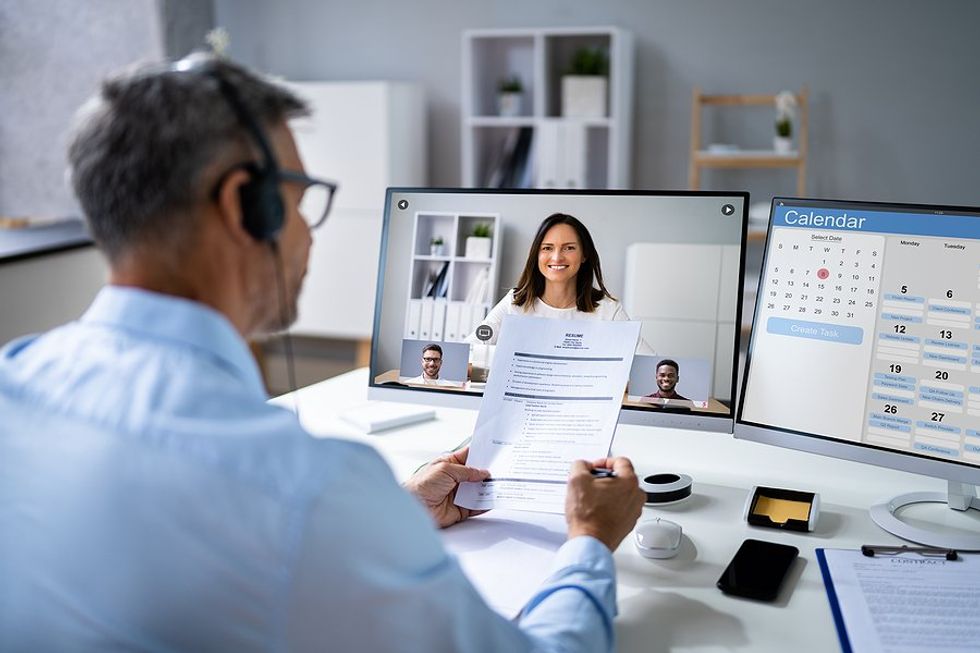
Poor body language can derail an interview regardless of how confident and well-spoken you are. Body language is as much a part of your communication style as what you say verbally—it's really about how you say it. Impressions are made within seconds of reviewing body language.
Consider the first step to entering an interview—the handshake. While it may take less than 10 seconds to complete a handshake, in that time, the interviewer has already developed an impression of your character based on eye contact and the firmness of your shake. A weak handshake and lack of eye contact can leave the impression you are timid and insecure. A sincere and firm handshake with eye contact expresses professionalism and confidence. An overpowering handshake with a fixed gaze may come across as overconfident and arrogant. So, be cautious with your next handshake and start the interview off with a positive impression.
In an interview, body language is present from head to toe. Consider the following...
Posture
Whether you are sitting or standing, your posture projects a level of confidence and engagement in the conversation. When one slumps, it implies to the interviewer a lack of confidence and interest. Sitting stiff as a rock implies nervousness and it creates an uncomfortable situation for building rapport. Sitting at the tip of the chair implies you don't want to be there. Lying back on the chair with your ankle on top of your other knee may appear unprofessional and too relaxed. In general, crossing your arms and legs may be interpreted as building a barrier.
To project professionalism, confidence, and engagement, consider sitting on the chair with your lower back touching or close to the back panel while leaning 10 degrees forward. Keep your hands relaxed in your lap or on the table, and your feet grounded on the floor. When standing, avoid crossing your arms or placing them in your pockets. The point is to project a balanced posture that is not limp or overly stiff.
Eye Contact
 Bigstock
BigstockEye contact allows you and the interviewer to connect beyond words alone. However, there is a fine balance between good eye contact and when eye contact becomes a weird gaze or stare that can make the other person feel uncomfortable. When you stare without having breaks in between, a casual conversation can come across as a lecture.
Whether you are listening or speaking, maintain eye contact with your interviewer for a couple of seconds at a time (no more than 7 to 10 seconds) and then glance away before returning eye contact again. If you are looking down to take notes, look up occasionally, especially when it appears a special point is being made or when you are asked a question.
Voice
 Bigstock
BigstockSpeed, tone, and pitch combined make an impression. Talking too fast can be hard to understand and appear as nervousness. When your tone projects apology or defense, you can come across as unconfident and insecure. When you don't make changes between your tone and pitch, you can sound monotone, making it more difficult for the other person to stay engaged.
Learn to take control of your voice. If you are nervous, it can come across in your pitch, so take a breath to help you relax before speaking. Be conscious of your tone and pitch to offer variation and to help emphasize certain points.
Bobblehead
 Bigstock
BigstockSome people have a tendency to bobble their heads as a gesture of agreement, but when you nod in excess during a conversation, it becomes a distraction and can be interpreted as though you are agreeing on everything for the sake of wanting to please. You can lose credibility in such instances.
To avoid appearing like a bobblehead, nod occasionally to show you are still engaged and have control over how you nod. You can also tilt your head slightly to the side as though you are trying to listen more carefully as another way to show you are engaged.
Extremities
 Bigstock
BigstockThere are people who do certain things out of habit, such as flaring their arms while talking, twirling their hair, playing with a pen in hand, rocking back and forth on a chair, and shaking or thumping their feet. Many of these actions occur unconsciously; however, these are distractions to the person you are speaking to and may be perceived as signs you are bored or have trouble focusing. Some people also touch their nose or face frequently when they are nervous. An interviewer may perceive this as a sign you are not being totally honest.
Be conscious of what you do with your hands, legs, and feet and that will help you take control of your movements. Be aware of your own body language and also read your interviewer's body language to give you hints about how they are responding to you.
The interview may start very formal, but as you both become acquainted with one another, the mood may relax and you may adapt your body language to reflect what you sense from the interviewer. There is no absolute rule around body language, but it would be wise to avoid any chance of being misinterpreted.
You can properly prepare your body language before heading into an interview by watching yourself in the mirror act out how you introduce yourself and speak. Another helpful way is to have a friend or colleague interview you and record the entire session. Review how you present yourself and become aware of problem areas to adjust before your interview.
Need more help preparing for your next job interview?
Become a member to learn how to land a job and UNLEASH your true potential to get what you want from work!
This article was originally published at an earlier date.
- How To Get Rid Of Interview Nerves ›
- 3 Things You DON'T Think About During Job Interviews (But Should) ›
- How To Avoid Appearing Overconfident During Job Interviews - Work It Daily | Where Careers Go To Grow ›
- 5 Tips To Ace Your Panel Interview - Work It Daily ›
- How To Master Nonverbal Communication In An Interview - Work It Daily ›

 Bigstock
Bigstock Bigstock
Bigstock Bigstock
Bigstock


